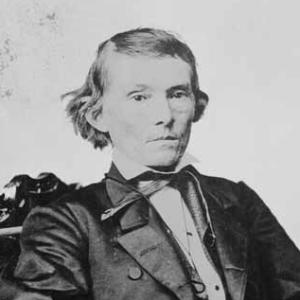
Section Branding
Header Content
Georgia Reflects On Secession
Primary Content

All this season I'm featuring the fascinating stories behind Georgia's Civil War sites. This week marks 150 years since Georgia lawmakers voted to secede from the United States. The room where they debated and voted is now in the Old Capitol Museum in Milledgeville. But not all lawmakers agreed disunion was a good idea. You can listen to my recent story about the divisions behind disunion on GPB Radio.
A half dozen white men dressed in mid-19th century waistcoats and blouses re-enact the political debate of 150 years ago:
“As delegates we solemnly gather today to consider the most serious issues concerning the future of Georgia, and her duty to remain in the Union, or her responsibility to leave it.”
Rick Joslyn is playing Georgia Secession Convention President George Walker Crawford. He and his fellow actors are in the original state House Chamber in Georgia’s Old Capitol building in Milledgeville. It was in this room, where delegates decided to leave the Union. John Geist is playing Thomas R.R. Cobb, who argued for secession.
“I believe the hearts of men are in his hands and I hear the voice of God speaking through his Providence and saying to his child “Be Free.”
“The whole of American political culture, the political party system, had been tearing itself apart principally over the issue of slavery. “
Dr. David Blight is a Professor of American History at Yale University. He says Georgia and other southern states were terrified for the future of slavery.
“For secession-leaning southerners, at least their argument at that moment … was that they should make their break then because their slave society, their labor system, their racial system as they knew it was about to be surrounded.”
That’s because Abraham Lincoln had just been elected. His new Republican Party opposed expanding slavery.
But not all Georgians wanted to secede immediately. Known as "cooperationists," these men wanted to see what Lincoln would do.
Among those moderates at the Georgia secession convention that day, was future Confederate Vice President Alexander Stephens. Todd Groce, President of the Georgia Historical Society, says men like Stephens saw immediate secession as too radical.
“Stephens says let’s wait, let’s wait to see what Lincoln does. This is revolution. This is going to call down the power of the federal government upon the people of Georgia.”
Still, immediate secessionists argued Georgia had helped create the Union, so it could leave it. Lincoln argued the Constitution did not allow for secession. Blight agrees.
“They weren’t really exercising any Constitutional right. They could theorize that they were. Many people still do. But it really was an act of Revolution.”
Even today, the debate continues. Protecting slavery was not the south’s only motivation for secession says Jane Simpson. She is a librarian at the Georgia Military College where the Old Capitol building is now a museum. She has read all the original documents:
“I think the main reason for Georgia’s secession was the issue of the trade embargoes, the economic situation. Slavery was a part of it course, but there were so many other things.”
Whatever the motivation, 208 delegates agreed Georgia should secede. 89 voted against secession. A few days later they reluctantly signed the document in a show of solidarity, but afterward threw their pens into the House Chamber fireplace.





